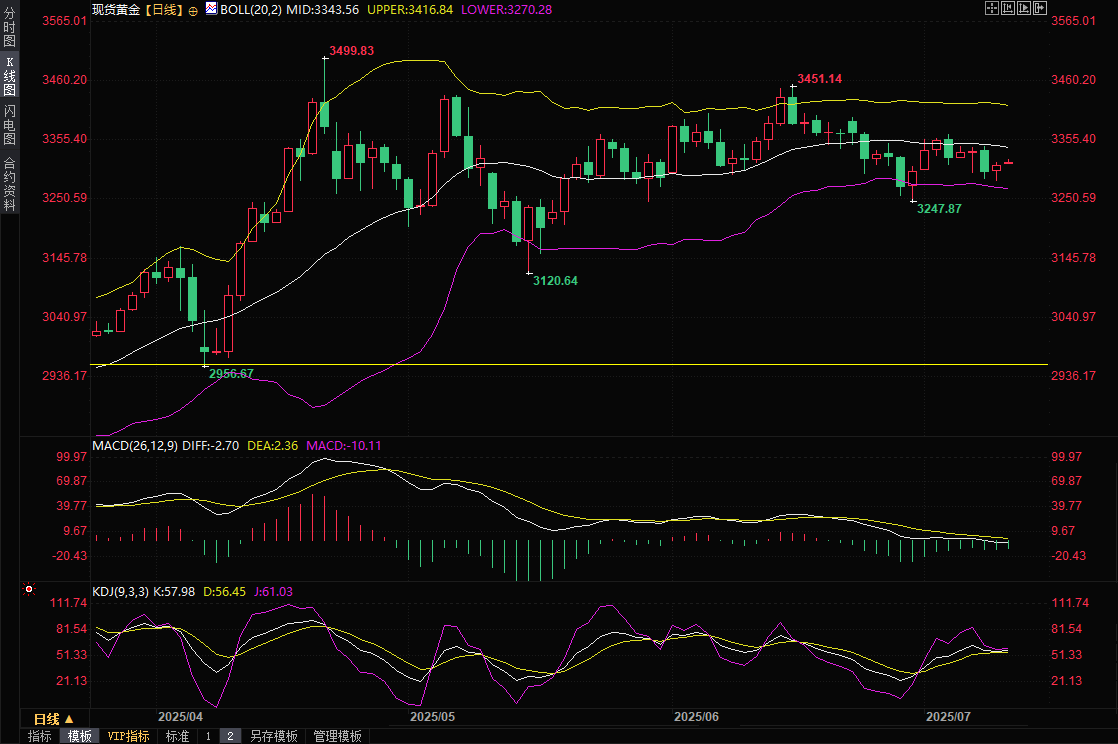Gold trading reminder: Risk aversion rebounded, U.S. Treasury yields fell, and gold prices rebounded strongly after hitting a two-week low
2025-07-10 07:24:01

1. Driving factors for gold price bottoming out and rebounding
1. Market volatility and rising risk aversion demand
Gold prices experienced twists and turns on Wednesday, falling to the lowest level since June 30 at $3,282.61 per ounce in early trading, and then rebounded in the New York session, regaining the $3,300 mark. Market uncertainty has become the main driver behind this fluctuation. Phillip Streible, chief market strategist at Blue Line Futures, pointed out that investors' safe-haven demand for gold has increased significantly amid market volatility, fiscal concerns and the widening of the US deficit. The global economy is facing multiple uncertainties, including geopolitical risks and unclear trade policies, which have prompted funds to flow into gold, a traditional safe-haven asset, providing support for gold prices to buy on dips.
2. The game between the strengthening of the US dollar and the US bond yields
Although safe-haven demand has provided support for gold prices, the strong performance of the US dollar has limited the upside of gold prices to a certain extent. The US dollar index hovered near its highest point in more than two weeks, making gold less attractive to overseas buyers. At the same time, the US 10-year Treasury yield fell from a high of more than two weeks to 4.34%, providing some support for the rebound in gold prices. The decline in US Treasury yields reflects that market concerns about the US fiscal outlook have eased, and strong demand for Treasury auctions also shows that investors' confidence in US assets has not been completely shaken. This dynamic balance between the US dollar and US Treasury yields has become an important factor affecting the short-term trend of gold prices.
2. Intensive trade negotiations between the United States and China
1. The EU’s urgent agenda
The European Union is accelerating its efforts to reach a trade deal with the United States to avoid further impacts on its economy from the August 1 tariff increase deadline set by the Trump administration. According to Reuters, the European Commission is discussing a number of measures with the United States, including cutting import tariffs on cars, setting quotas, and providing export credits for EU automakers. As one of the pillars of the EU economy, the importance of the automotive industry is self-evident. An EU diplomat made it clear that the reduction of auto tariffs is the "red line" for reaching an agreement. Currently, EU automakers face a 25% import tariff from the United States, which is particularly significant for car companies such as BMW and Mercedes-Benz that have production bases in the United States.
2. Negotiation progress and potential impact
The progress of the negotiations is remarkable. According to sources, the two sides have had in-depth discussions on automobile tariff rates and quotas, and even proposed an innovative mechanism: providing tariff credits for automobile manufacturers that produce and export in the United States. This mechanism will benefit companies such as BMW and Mercedes-Benz, and may also attract Volkswagen to make additional investments in the United States. EU Trade Commissioner Šefčović said that a preliminary agreement is expected to be reached in the next few days. However, the Trump administration has reservations about the quota system, which adds uncertainty to the negotiations. The results of the trade negotiations will not only affect the export competitiveness of the EU automotive industry, but may also indirectly affect the gold market by affecting the global supply chain and inflation expectations.
3. The trade-off between the Fed’s policy and inflationary pressure
1. The Fed’s cautious stance
The minutes of the Fed's June 17-18 meeting revealed policymakers' cautious attitude toward the current economic situation. Despite Trump's repeated calls for an immediate and substantial rate cut and for the resignation of Fed Chairman Powell, the minutes showed that only a few policymakers supported a rate cut in July, with most more concerned about inflationary pressures that could be pushed up by trade tariffs. The Fed expects price increases from tariffs to be "transient or mild," but there is still great uncertainty about their specific impact. Therefore, the Federal Open Market Committee unanimously decided to maintain the current interest rate range of 4.25%-4.50%, reflecting its confidence in economic growth and the robustness of the labor market.
2. Expectations of interest rate cuts and market reactions
Although the possibility of a rate cut in July is considered to be minimal by the market, investors generally expect the Fed to cut interest rates for the first time in September and cut interest rates by 50 basis points by the end of the year. The minutes of the meeting showed that some policymakers believed that the current interest rate was close to a neutral level, which provided room for future rate cuts. However, stronger-than-expected employment data and uncertainty about tariff policies have made the Fed highly cautious in adjusting monetary policy. Priscilla Thiagamoorthy, senior economist at BMO Capital Markets, pointed out that the Fed prefers to observe the outlook for inflation and economic activity before taking action. This policy uncertainty further enhances the appeal of gold as a safe-haven asset.
4. Robust performance of the U.S. Treasury market
1. Strong demand for Treasury auctions
The U.S. Treasury Department auctioned $39 billion of 10-year Treasury bonds on Wednesday, with a winning rate of 4.362% and a bid-to-cover ratio of 2.61, the highest since April. This strong demand shows that the market's confidence in U.S. Treasury bonds remains solid. Kim Rupert, managing director of Action Economics, said that concerns about "selling U.S. assets" have been greatly weakened. Treasury Secretary Bessant also made it clear that the issuance of long-term Treasury bonds will not be increased at the current interest rate level, providing further support for long-term bond investment.
2. Falling yields and market confidence
The 10-year Treasury yield fell 7.7 basis points to 4.34% on Wednesday, and the two-year Treasury yield also fell to 3.862%. The decline in yields reflects the easing of market concerns about the deteriorating fiscal outlook, and also provides a favorable environment for the rebound in gold prices. However, market uncertainty about Trump's tariff policy may still suppress foreign investors' demand for US assets, which provides potential long-term support for the gold market.
5. Opportunities and challenges of gold investment
Overall, the current fluctuations in gold prices are affected by multiple factors. The uncertainty of trade negotiations, the strength of the US dollar and the cautious policy of the Federal Reserve have jointly shaped the complex pattern of the gold market. In the short term, the strengthening of the US dollar and the fluctuation of US bond yields may continue to suppress gold prices to a certain extent, but the uncertainty of the global economy and the continued rise in risk aversion demand provide solid support for gold.
Pay attention to the performance of initial jobless claims and the speeches of Federal Reserve officials during this trading day.

(Spot gold daily chart, source: Yihuitong)
At 07:21 Beijing time, spot gold is trading at $3,318.32 per ounce.
- Risk Warning and Disclaimer
- The market involves risk, and trading may not be suitable for all investors. This article is for reference only and does not constitute personal investment advice, nor does it take into account certain users’ specific investment objectives, financial situation, or other needs. Any investment decisions made based on this information are at your own risk.










